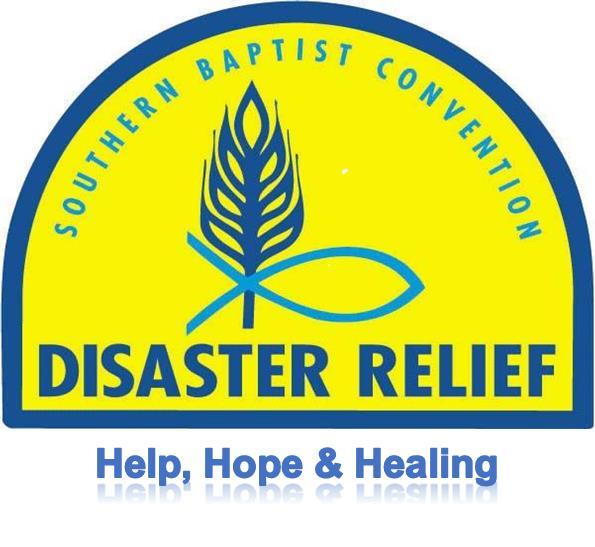







Mission Statement:

Southern Baptist Disaster Relief is a Christcentered partnership of national, state and associational ministries serving through the local church to bring help, healing and hope to individuals affected by disasters.

Vision Statement:

Southern Baptist Disaster Relief will be a welldefined, unified disaster response organization, demonstrating the love of Christ by providing physical and spiritual help to those affected by disasters.









• Southern Baptist Disaster Relief (SBDR) is a Christ-centered partnership of national, state and associational ministries serving through the local church to bring help, healing and hope to individuals affected by disasters.
• SBDR began in 1967 and has grown to be one of the largest and most respected disaster organizations in the U.S. and around the world.
• Assessment is a vital component of the Disaster Relief Recovery Ministry.
Unless otherwise noted, all scriptures are taken from the Christian Standard Bible copyright 2017 by Holman Publishers (HCSB). Used by permission.
Galatians 6:9-10
9 So we must not get tired of doing good, for we will reap at the proper time if we don’t give up. 10 Therefore, as we have opportunity, we must work for the good of all, especially for those who belong to the household of faith.
Philippians 2:13
13 For it is God who is working in you, enabling you both to desire and to work out His good purpose
Matthew 25:40
40 “And the King will answer them, ‘I assure you: Whatever you did for one of the least of these brothers of Mine, you did for Me.’
Ephesians 4:2
2 with all humility and gentleness, with patience, accepting[a] one another in love
• Assessment is the front end of the Disaster Relief Recovery Ministry.
• All members of the Assessment Team should have had Assessment training. An exception to this might be the Chaplain, though it would be helpful if he/she has also been trained in assessment.
• Three (3) person teams are desired.
o Lead Assessor – Asks most of the questions
o Assessor Assistant – Responsible for filling out forms
o Chaplain - Provide emotional and spiritual support
• The Lead Assessor and Assessor Assistant should be credentialed in the specialty reflecting the assessments (Chainsaw, Flood Recovery, Fire Recovery, or Temporary Roof) and have been deployed in a similar disaster.
• YOU SHOULD NEVER GO BY YOURSELF


• All team members should wear the appropriate safety equipment when entering a disaster site.


• After several assessments, the Lead Assessor may trade roles with the Assessor Assistant.


• Upon arrival at the disaster area, report to the Baptist Command Post where the Incident Management Team (IMT) is located
• If no IMT has been established, contact local church pastors, associational missionaries or Director of Missions. You may have to go to the police, sheriff, local fire department or local emergency management to find out where the most critical damage is located.
• The IMT, local county offices, emergency services (e.g. fire department, 911 dispatch), or a local realtor may be able to provide you with maps.
• These maps should show streets, and prominent landmarks. Street signs and house numbers may have been destroyed in the disaster. It could be helpful to have a hand compass for orienting the map in unfamiliar areas.
• It may be helpful if copies of maps of the affected area, especially those parts in which homes were damaged, can be laminated.
• The laminated maps will also be of great help to the Unit Leaders when they begin their work.
• When multiple assessment teams are used, a master map should be marked off in grids showing the assignment of the various teams.
• In many areas, a GPS device may be used. This will generally give turn-by-turn directions to the property address Keep in mind that in remote areas the device may not have all the roads in its system and may not work at all in steep canyons or other similar terrain. There also may be magnetic properties in the area that affect the GPS.
• In some situations, when properties are scattered over great distances, a local guide or driver might be helpful.
• Assessors should wear DR shirts, caps, and badges
• Assessors should print business cards with DR logo and assessor’s name and contact information to give to the property owner
o Avery 28371, 8879, 28669 or similar products may be used to print business cards
• It could also be helpful to carry DR door hangers to leave when the home owner is not present.
• Assessor flags or signs could be posted in the yard next to the road for quick recognition by Recovery Teams.
• DO NOT PROMISE the property owner that we will work his/her property on any given date.
• Emphasize that as a volunteer organization with limited funds, we do our best to respond to every request in a timely way as resources and volunteers are available.
• Let the owner know we will attempt to contact them on the day before we begin work, especially if they request to be present.
• Inform the property owner that what you are doing is an assessment of work that might be needed.
• If the property owner does not keep the appointment, attempt to do as much of the assessment as possible.
• When permission is given, take one or more digital pictures of the area to be worked.
• Complete all appropriate Assessment Forms including a brief description and the address of the property to be worked on the Assessment-Property Area Form.
• At the end of the visit take a picture of the approach to the site.
• In some situations, assessors may have to seek out property owners on their own and offer them our ministry. If possible, get names and contact numbers of displaced families from Red Cross, Salvation Army, County government, local churches, or community service organization.
• Look for “The Person of Peace”, that individual in the community that can open doors and establish your credibility to the residents. When you have names, and contact information, first try to call and set up appointments.
• Your team may have to drive around the disaster area to stop and talk with people who are on their property. Even if they don’t request assistance, your visibility and story will begin to spread through the community and open doors for you.
• Always remember, you are representing Jesus, our Lord, and witnessing to His love for these wounded people. Even if they are suspicious or hostile, respond with grace and love.
• If Work Sites are off paved roads and have been occupied by persons who are very private, the Assessors will need to be cautious in their approach. Looters may have already violated their property. Some structures may not have been legally permitted. Be cautious if there is evidence of illegal drug or other activities. Do Not Be Judgmental. The presence of questionable activities should be noted on appropriate forms.
• If the activity presents a real physical danger, terminate the assessment and notify the appropriate authorities.
• Chainsaw
• Flood Recovery
• Fire Recovery
• Temporary Roof
• Flood Recovery
o Property Owner’s Request for Assistance
o Assessment – Flood Recovery
o Assessment – Property Area
• Fire Recovery
o Property Owner’s Request for Assistance
o Assessment – Fire Recovery
o Assessment – Property Area
• Chainsaw
o Property Owner’s Request for Assistance
o Assessment – Chainsaw
o Assessment – Property Area
• Temporary Roof
o Property Owner’s Request for Assistance
o Assessment – Temp Roof
o Assessment – Property Area

Assessors should be prepared to complete one or all Assessment forms for each property.
• Qualifications for Assistance
o Anyone that needs our help qualifies for our assistance.
o We will look at all damaged homes and buildings.
o REMEMBER THAT WE HAVE BEEN SENT TO MINISTER TO ALL. WE HOPE THAT WHAT WE DO WILL LEAD SOMEONE TO CHRIST
• Mobile Homes
o Check Floors for Safety
• Modular Homes
o Check Floors for Safety
• Commercial Property
o SBDR generally does not work on Commercial property unless some extenuating circumstances exist. Refer to the IMT for guidance.
• Church Buildings
o Based on available man power and resources, churches are High Priority
• Rental Property
o SBDR generally does not work on Rental Property unless extenuating circumstances exist. Refer to the IMT for guidance.

Priority is generally based on the people and circumstance and not the work.
• Priority 1
o No Insurance\
o Under Insured
o Primary Home
• Priority 2
o No Insurance
o Under Insured
o Secondary Home
• Priority 3
o Fully Insured
o Primary or Secondary Home
o Rental Property
o Out Building, Storage Building, Barn
Sub Priorities – Any job can be moved up in Priority based on circumstances
• Elderly, Living Alone
• Health Issues
• Can’t care for themselves
• Wheel chair bound
• Single with Children
• Hearing, visually impaired
• Mentally Challenged
• First Responders
o Police, Fire, Clergy, or other emergency personnel
• Church Buildings
o Depending on available manpower
o Do not focus entirely on church buildings to the exclusion of the neighborhood
• Other Circumstances
Sub Priorities – Priorities may also be adjusted or work declined based on available manpower or equipment needed or other circumstances
• Accessibility of Site
• Availability of Dumpsters
• Availability of Homeowner
• Power Lines, Standing Water, etc.
• Unsafe Structure or Situation
Chainsaw Priorities – Priorities for chainsaw work may be adjusted based on the work required.
• Priority 1
o Anything that will expose the inside to weather. (Missing windows, doors, or walls) caused by falling trees.
o If a tree has fallen and pulled the power line down from the house connection to the pole. (Once the tree is removed, the power can be restored.) Make sure the power is off.
5
o Blocked driveway
• Priority 2
o Trees in yard that hit a well house or storage building
o Smaller trees on house/building (no holes in roof)
o Large trees in yard; these jobs need expertise to cut trees up correctly
• Priority 3
o Small trees in yard that did not hit anything and are not blocking anything
o Jobs that require people with minimal chainsaw experience
o Small limbs and brush removal required


Let common sense prevail. We are here to minister to hurting people which sometimes will over ride all other priority issues.
• Begin assessment work by making an appointment (usually the day before) to meet with the Property Owner(s) who have filled out the “Property Owner’s Request for Assistance” form.
• These may have been distributed at a government Local Assistance Center (LAC), Community Information meetings or at a Red Cross Assistance Center.
• Set a mutually agreed time to meet and be sure to be at the site at that agreed time.
• It is best not to schedule appointments too close together. Ample time should be allowed for finding addresses in areas in which it is often easy to get disoriented.
• Also, time should be allowed for the team to minister to the property owner(s) and for the Chaplain to do his/her work.

• Before beginning assessments, obtain information regarding state and local regulations and ordinances that could impact the work. This information should be available from the IMT or local governmental officials.
o Debris disposal
o Hazardous waste

The Chaplain should assess the emotional and spiritual status of the owner and family.
• The Chaplain should ask permission to pray for the displaced family before ending the assessment.
• A copy of the Chaplain’s comments should be attached to the “Property Owner’s Request for Assistance” being careful not to violate confidentialities.
• The Chaplain should have a Bible, and appropriate tracts available. Be sensitive to opportunities to minister and give witness.
Before beginning the Assessment insure the “Property Owner’s Request for Assistance” form has been completed and signed by the home owner.

• Ensure that the address and other information on the form is correct.

• WRITE THE PROPERTY OWNER’S NAME, ADDRESS AND CONTACT INFORMATION on all Assessment Forms and other necessary Forms

• Introduce all the members of the team.
• Assessors should walk the property with the property owner, getting as much information as possible about the owner’s desires.
• Always ask permission to enter a home
• Make sure they are the owner of the property.

• Ask if there were any toxic chemicals or products being stored anywhere on the property.


• Ask if poison ivy or poison oak is growing within the area to be worked.

• Are poisonous snakes or other hazards likely to be encountered?

• Are there missing pets?


• Have stray animals been sighted around the property?

• Ask the property owner if a hazardous waste inspection has taken place.

• Let the property owner know that he/she may be responsible for cost of the disposal of such waste if so ordered by the county.

• If dangerous items, such as asbestos, is present, no work will be done until they are removed. Refer to the IMT for guidance.


• Be sure to mark the location of any septic tank, gas, water & sewer lines or wellheads on the property and identify them on “Assessment – Property Area” form.


• Clearly mark any trees to be removed.

• Also mark suggested locations for debris bins and/or piles. These should include as needed: scrap metal, burned debris, ash, concrete blocks (cement, tiles, stucco removed from wire), hazardous or toxic items, Trees and brush.

• Do not “over promise” the Property Owner

o Work to be completed



o Schedule

• Share with the Property Owner that the work may not be completed and there is no set schedule. All work is based on availability of volunteers.

• The Unit Leader responsible for the work may find additional items that need completed.


• Ensure that ALL forms are completely filled out. Incomplete forms could delay the work and possibly require additional assessments.


• Find out any special instructions from the property owner.
• Find out if there are particular salvage items on the property that the owner does not want on the debris piles
• Ensure Assessment Forms are completely filled out including priority designation.
• Identify with stakes and tape the areas that are to be sifted.

• Identify a potential location away from the building site and the debris piles or bins where any found items will be placed

• This location will be used for keepsake salvage items that have survived the fire.


• Identify location for debris (or dumpster).

• Note all marked areas on the Assessment – Property Area form.



• Let the owner know that we do not normally break up slabs or knock down foundations


• Standing walls can be demolished if equipment will be available to safely handle the task.


• If such walls are unstable, volunteers will not be able to work around them until they are demolished.


• Map the site.


• Find out any special instructions from the property owner.

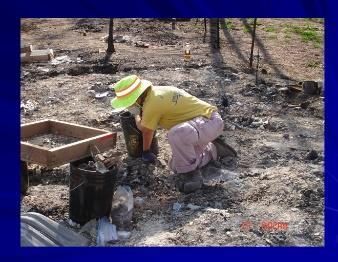
• Find out if there are particular salvage items on the property that the owner does not want on the debris piles.
• Ensure all Assessment forms are completely filled out including priority designation.
• Locate appropriate location for debris (or dumpster) – not on the water meter.
• Note all marked areas on the Assessment – Property Area form

• Determine depth of water and degree of damage

• Determine if power wash will be required.

• Determine with home owner disposition of damaged furniture, clothes, etc.


• Note on the Assessment form any needs for heavy equipment, chainsaw work, chop saw work, or other specialized equipment

• Include as much other helpful information as possible on the assessment forms. Use back of the form for any additional information or attach additional sheets.

• Map the site.




• Take pictures of particularly hazardous situations.



• Determine location of trees to be removed

• Determine location for stacking cut wood and brush.

• Note all marked areas on Assessment – Property Area form

• Determine what type of chainsaw unit will be required

• Determine need for heavy equipment, or other specialized equipment (Skid Steer, Man Lift, Climbers).



• Ensure all Assessment forms are completely filled out including priority designation



• Map the site.





• Determine extent of damage. Is structure safe
• Determine need for repair of decking
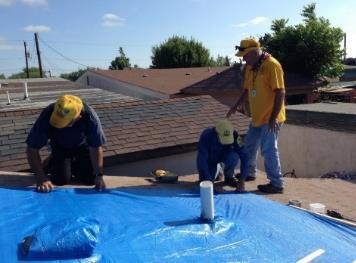
• Estimate tarp size and amount of tarp material that will be needed.
• Note any need for other units (chainsaw, etc.)
• Include as much other helpful information as possible on the assessment forms
• Ensure all Assessment forms are completely filled out including priority designation

• Make sure all forms are filled out and there are clear directions for finding the property.


• A Map-Quest or Google Map print out to the address location might be obtained and attached. (If possible, obtain GPS coordinates/drop a pin and forward to the Incident Command Team.)

• Keep separate any assessment forms which do not have signed releases, but turn them into the Operations Officer separately.

• Upon completion, assign a Job Priority rating and submit the forms to the local IMT. The IMT will assign jobs to a Unit Leader and team.

• In the absence of a local IMT, forms will need to be submitted as required by the controlling state convention.



Personal Items
• DR shirt, hat, ID badge
• Long pants
• Sunglasses
• Flashlight
• Hard sole shoes or appropriate boots (no tennis shoes)
• Insect repellent
• Sunscreen
• Lip balm
• Compass
• Anticipated Safety Equipment
o Hardhat
o Mask - N95 or equivalent
o Safety glasses
o Gloves
o Hand Sanitizer
• Small personal first aid kit
• Lunch provision
• Snack food
• Bottled water
• Wide brim hat (for hot sunny days)
• Personal medications
If spending the night
• Sleeping bag & air mattress (single size) + pump or cot
• Pillow
• Flashlight
• Changes of clothing
• Laundry bag
• Personal health & hygiene needs

• Towel & wash cloth

Task Related

• Clipboard or portfolio
• Notepad
• Pens
• Digital Camera (may be on phone)
• GPS Device (optional)
• Black Permanent Marker
• Disaster Relief Business Cards
• DR Door Hangers
• Copies of Required Forms
• Signs to Identify Properties we are working – DR Logo, place for Owner Name & Address
• Plastic sheet protectors for signs
• Heavy Duty Stapler – or hammer and tacks
• Roll of yellow caution tape
• Rolling Distance Measuring Device (optional)
• Street map of area
• Cell Phone or other communication method compatible with Incident Command Team
• Stakes, Ribbons and Flags (red or orange)
• Measuring Tape
List of Important Phone Numbers including:
• Incident Management Team (IMT)
• County Officials
• Response Agency Personnel
• Debris Bin Provider
• Auto Recycle Company
• Local Contacts
• State DR Director


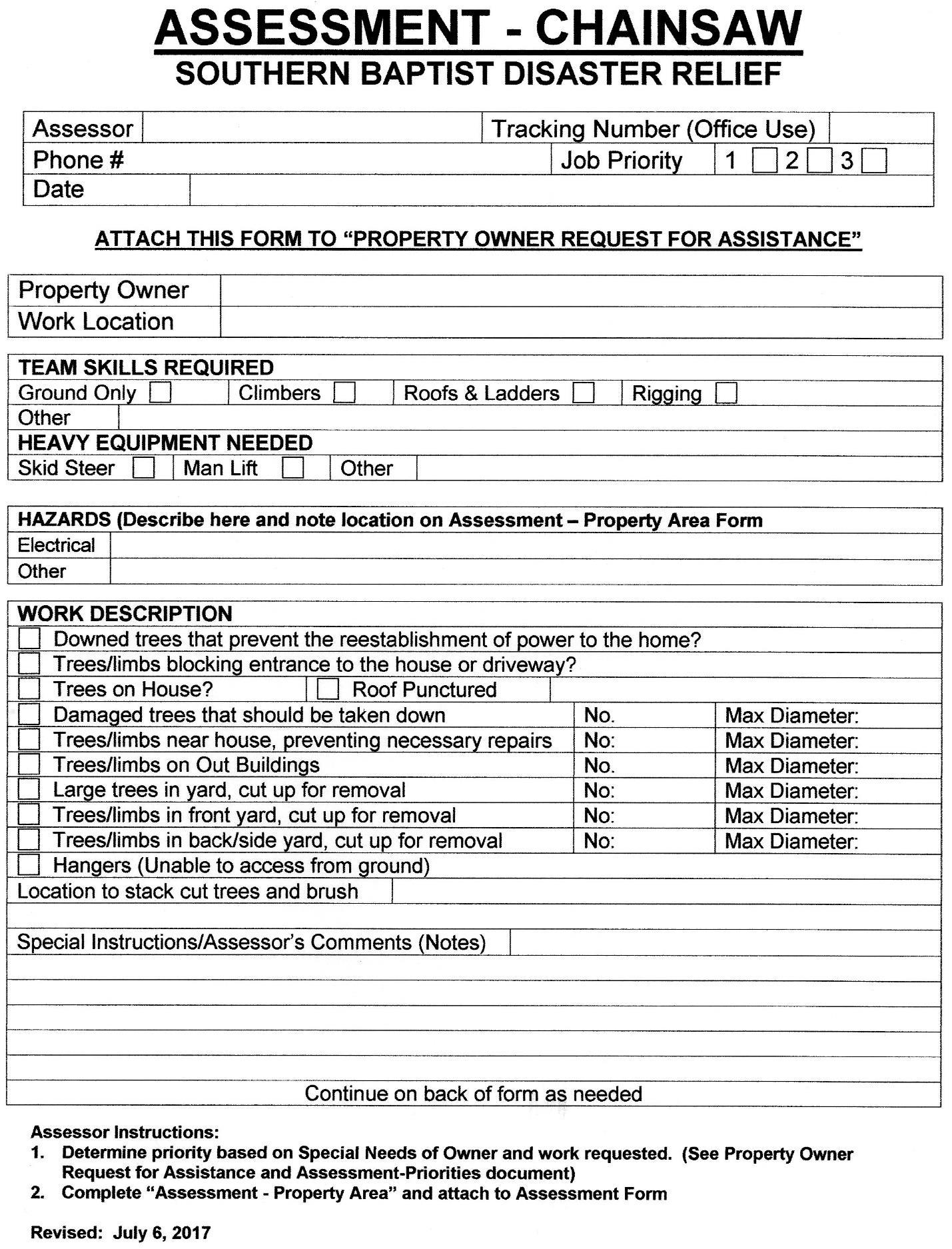
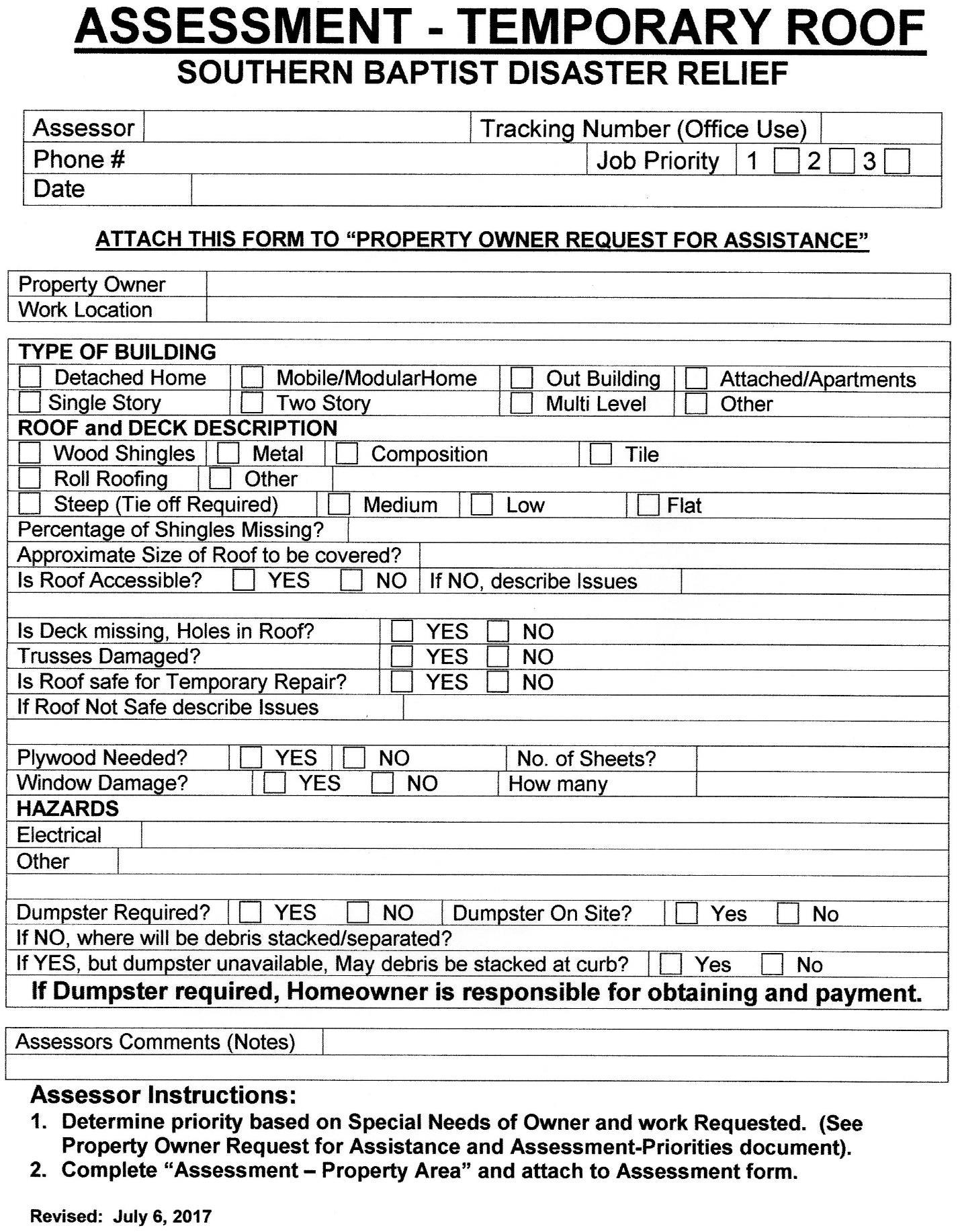


Be Prepared for the Unexpected – Be Flexible
Assessments are like a box of chocolates; you never know what you are going to get into.